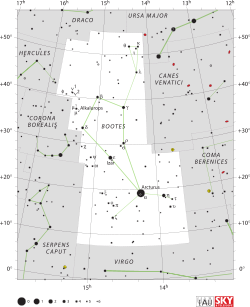Rho Boötis
| Observation data Epoch J2000 Equinox J2000 | |
|---|---|
| Constellation | Boötes |
| Right ascension | 14h 31m 49.78962s[1] |
| Declination | +30° 22′ 17.1781″[1] |
| Apparent magnitude (V) | 3.59[2] |
| Characteristics | |
| Spectral type | K4 III[3] |
| U−B color index | +1.44[2] |
| B−V color index | +1.30[2] |
| R−I color index | 0.65 |
| Astrometry | |
| Radial velocity (Rv) | −13.57±0.19[4] km/s |
| Proper motion (μ) | RA: –100.90[1] mas/yr Dec.: +120.73[1] mas/yr |
| Parallax (π) | 20.37 ± 0.18 mas[1] |
| Distance | 160 ± 1 ly (49.1 ± 0.4 pc) |
| Absolute magnitude (MV) | +0.27[3] |
| Details | |
| Mass | 1.0–1.4[5] M☉ |
| Radius | 21.57±0.25[5] R☉ |
| Luminosity | 131.9±6.8[5] L☉ |
| Surface gravity (log g) | 1.85±0.05[6] cgs |
| Temperature | 4,298±56[5] K |
| Metallicity [Fe/H] | −0.19±0.10 [6] dex |
| Age | 10.11±2.82[6] Gyr |
| Other designations | |
| Database references | |
| SIMBAD | data |

Rho Boötis, Latinized from ρ Boötis, is a single,[7] orange-hued star in the northern constellation of Boötes. It is visible to the naked eye with an apparent visual magnitude of 3.59.[2] Based upon parallax measurements, it is located at a distance of approximately 160 light-years (49 parsecs) from Earth. It is moving toward the Sun with a radial velocity of −13.6 km/s.[4] There is an optical companion, a magnitude 11.5 star, located 34.7 arcseconds away along a position angle of 345° (as of 2013).[8]
This is an evolved K-type giant star, currently on the red giant branch, with a stellar classification of K4 III[3] and an estimated age of 10[6] billion years. Since 1943, the spectrum of this star has served as one of the stable anchor points by which other stars are classified.[9] It has around 1.2[5] times the mass of the Sun and has expanded to 22[5] times the Sun's girth. The star is radiating 132[5] times the Sun's luminosity from its enlarged photosphere at an effective temperature of about 4,300 K.[5]
In Chinese, 梗河 (Gěng Hé), meaning Celestial Lance, refers to an asterism consisting of ρ Boötis, ε Boötis and σ Boötis.[10] Consequently, the Chinese name for ρ Boötis itself is 梗河三 (Gěng Hé sān, English: the Third Star of Celestial Lance.)[11]
References
- ^ a b c d e van Leeuwen, F. (November 2007), "Validation of the new Hipparcos reduction", Astronomy and Astrophysics, 474 (2): 653–664, arXiv:0708.1752, Bibcode:2007A&A...474..653V, doi:10.1051/0004-6361:20078357, S2CID 18759600.
- ^ a b c d Jennens, P. A.; Helfer, H. L. (September 1975), "A new photometric metal abundance and luminosity calibration for field G and K giants", Monthly Notices of the Royal Astronomical Society, 172 (3): 667–679, Bibcode:1975MNRAS.172..667J, doi:10.1093/mnras/172.3.667.
- ^ a b c Cardini, D. (January 2005), "Mg II chromospheric radiative loss rates in cool active and quiet stars", Astronomy and Astrophysics, 430: 303–311, arXiv:astro-ph/0409683, Bibcode:2005A&A...430..303C, doi:10.1051/0004-6361:20041440, S2CID 12136256.
- ^ a b Massarotti, Alessandro; et al. (January 2008), "Rotational and Radial Velocities for a Sample of 761 HIPPARCOS Giants and the Role of Binarity", The Astronomical Journal, 135 (1): 209–231, Bibcode:2008AJ....135..209M, doi:10.1088/0004-6256/135/1/209.
- ^ a b c d e f g h Berio, P.; et al. (November 2011), "Chromosphere of K giant stars. Geometrical extent and spatial structure detection", Astronomy & Astrophysics, 535: A59, arXiv:1109.5476, Bibcode:2011A&A...535A..59B, doi:10.1051/0004-6361/201117479, S2CID 17171848.
- ^ a b c d Reffert, Sabine; et al. (2015), "Precise radial velocities of giant stars. VII. Occurrence rate of giant extrasolar planets as a function of mass and metallicity", Astronomy & Astrophysics, 574: A116, arXiv:1412.4634, Bibcode:2015A&A...574A.116R, doi:10.1051/0004-6361/201322360, hdl:10722/215277, S2CID 59334290.
- ^ Eggleton, P. P.; Tokovinin, A. A. (September 2008), "A catalogue of multiplicity among bright stellar systems", Monthly Notices of the Royal Astronomical Society, 389 (2): 869–879, arXiv:0806.2878, Bibcode:2008MNRAS.389..869E, doi:10.1111/j.1365-2966.2008.13596.x, S2CID 14878976.
{{citation}}: CS1 maint: unflagged free DOI (link) - ^ Mason, Brian D.; et al. (2001), "The 2001 US Naval Observatory Double Star CD-ROM. I. The Washington Double Star Catalog", The Astronomical Journal, 122 (6): 3466–3471, Bibcode:2001AJ....122.3466M, doi:10.1086/323920.
- ^ Garrison, R. F. (December 1993), "Anchor Points for the MK System of Spectral Classification", Bulletin of the American Astronomical Society, 25: 1319, Bibcode:1993AAS...183.1710G, retrieved 2012-02-04
- ^ (in Chinese) 中國星座神話, written by 陳久金. Published by 台灣書房出版有限公司, 2005, ISBN 978-986-7332-25-7.
- ^ (in Chinese) AEEA (Activities of Exhibition and Education in Astronomy) 天文教育資訊網 2006 年 6 月 29 日

